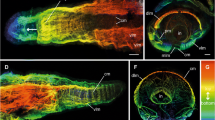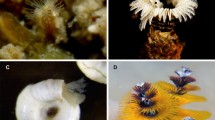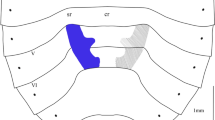Summary
Under various circumstances the tentacular crown of some sabellid polychaetes becomes detached from the body. Separation occurs always at a preestablished zone of abscission at the base of the crown. We used electron microscopy to study the abscission zone of Sabella penicillus, both in specimens whose crown was intact and in those whose crown had separated.
The abscission zone is within the intermediate layer, between the crown skeleton and the body wall musculature, and only structures supported by the crown skeleton separate from the animal's body. Abscission involves a rupture of the paramyosin muscle cells which form bridges connecting extensions from the epimysium of the body wall musculature and from the cartilage matrix of the crown. After abscission the anterior and posterior ends of the cells remain in place on the crown and body respectively.
Sabella penicillus appears able to control the loss of its tentacular crown, so this abscission is a kind of autotomy. Under some circumstances autotomy of the crown may permit escape or confer some surgical benefit to the animal. Using standard histology we found the same anatomical provision for crown abscission in a variety of sabellids. We conclude that differences in their capacities to autotomize the crown have a behavioral/physiological basis rather than an anatomical one.
Similar content being viewed by others
References
Berrill NJ (1931) Regeneration in Sabella pavonina (Sav.) and other sabellid worms. J Exp Zool 58:495–523
Bonar DB (1972) Feeding and tube construction in Chone mollis Bush (Polychaeta, Sabellidae). J Exp Mar Biol Ecol 9:1–18
Clark RB (1955) The posterior lobes of the brain of Nephtys and the mucus-glands of the prostomium. Q J Microsc Sci 96(4):545–565
Dales RP (1961) Observations on the respiration of the sabellid polychaete Schizobranchia insignis. Biol Bull 121:82–91
Eylers JP (1976) Aspects of skeletal mechanics of the starfish Asterias forbesi. J Morphol 149:353–358
Fauvel P (1927) Polychètes sédentaires. Addenda aux Errantes, Archiannélides, Myzostomaires. Faune Fr 16:1–494
Fredericq L (1883) Sur l'automie ou mutilation par voie réflexe comme moyen de défense chez les animaux. Arch Zool Exp Gén 1:413–426
Kryvi H (1975) Paramyosin muscle cells interposed between the longitudinal muscles and the cartilaginous skeleton of Sabella penicillum (Annelida). Protoplasma 84:257–272
Kryvi H (1977) The fine structure of the cartilage in the annelid Sabella penicillum. Protoplasma 91:191–200
McVean A (1975) Autotomy. Comp Biochem Physiol 51A:497–505
Millonig G (1962) Further observations on a phosphate buffer for osmium solutions in fixation. V. Internat Congress Electron Microscopy II, 8
Nicol EAT (1931) The feeding mechanism, formation of the tube, and physiology of digestion in Sabella pavonina. Trans R Soc Edinburgh 56:537–598
Sander F (1976) The respiratory significance of the Sabellastarte magnifica branchial crown. Comp Biochem Physiol 53A:263–264
Steedman HF (1960) Section Cutting in Microscopy. Springfield CC Thomas pp 172
Takahashi K (1967) The catch apparatus of the sea-urchin spine I. Gross histology. J Fac Sci University Tokyo 11(2):109–130
Wells GP (1951) On the behavior of Sabella. Proc R Soc London (B) 138:278–299
Wells GP (1952) The respiratory significance of the crown in the polychaete worms Sabella and Myxicola. Proc R Soc London (B) 140:70–82
Author information
Authors and Affiliations
Rights and permissions
About this article
Cite this article
Kennedy, B., Kryvi, H. Autotomy in a polychaete: Abscission zone at the base of the tentacular crown of Sabella penicillus . Zoomorphology 96, 33–43 (1980). https://doi.org/10.1007/BF00310075
Received:
Issue Date:
DOI: https://doi.org/10.1007/BF00310075




